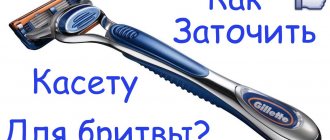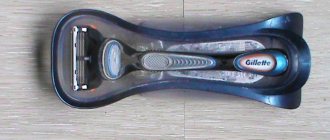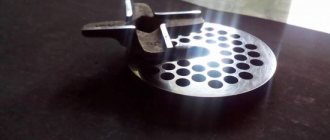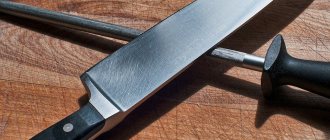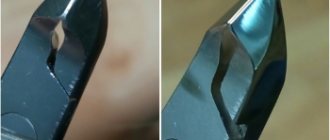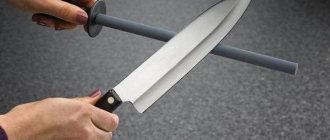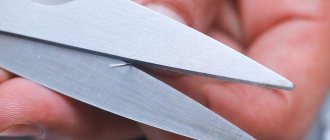Sharpening manicure tools is a very important process. This is especially true for those tools that have just been purchased, because it is not a fact that tweezers, nippers or other manicure tools were carefully sharpened at the manufacturer’s factory. Sharpening is also necessary for those manicure accessories that are used for a long time, since over time they can wear down and become dull. That's why at one point you may need to sharpen your manicure tools.
Rules of care
For manicure accessories to last a long time, they need to be well cared for. It is very important to store your tools correctly. Most often, they become unusable precisely because of improper storage.
Regular and timely care of manicure accessories will ensure their comfortable use and long service life.
- Scissors, wire cutters and tweezers must be stored in special cases , otherwise notches and unevenness may form on their surface. If you don't have a special case, you can wrap them in soft cloth.
- Do not store manicure accessories next to each other , avoid sudden temperature changes and high humidity.
- Place all cutting tools with the blade facing up or on its side .
- Scissors and wire cutters should be oiled .
Rules for working at home
Regardless of what tool is used, you need to know how to sharpen metal scissors at home correctly to get a good result
It is important to know 4 rules:
- It is necessary to take into account the factory sharpening angle. Self-sharpening of manicure or other scissors is carried out only at the established angle. If you break the rule, you can permanently damage the tool for manicure and cuticle trimming.
- The tool sharpens towards itself. Movements must be constantly controlled; you cannot sharpen the side cutter using back and forth movements. Tools can be sharpened from the nose to the rings.
- Fighting burrs. If there are burrs after sharpening, they are removed with a fine-grained abrasive. The only exception is hairdressing equipment; it cannot be made too sharp.
- Checking the work. It is made according to the material for which the tool is intended. For example, if tailor scissors have been sharpened, they need to be checked on the fabric. A thin piece of fabric is taken, hung and cut. If the cut is smooth and pieces of fabric are not caught, it means the job was done correctly.
If the design of the scissors allows, then it is better to disassemble them to simplify the task of how to sharpen nail clippers at home. The blades are sharpened separately, so it is more comfortable to work, and the result is better.
Signs of a dull instrument
Typically, a blunt tool has jagged edges; sometimes of scissors and wire cutters differ The tips and cutting edges become so thick that it is almost impossible to grip the skin or remove an ingrown toenail.
The frequency of sharpening depends on how often you use the manicure set. Usually the need for it occurs once every 2-6 months .
This video will tell you how to sharpen nail clippers:
Signs of a well-sharpened tool
- Cuts the nail plate, rough skin and cuticle smoothly, with the entire blade, but especially well at the tips.
- Cuts in a thin layer.
- Causes deep deformations.
- Does not tear or pull the skin.
- It runs smoothly and cuts well without pressure.
Appearance of a well-sharpened tool
- The working blades are free from nicks, scratches and stains;
- the tips of the scissors and nippers are thin and equal in length and width;
- the cutting blade is uniform and has no sharp breaks;
- when closed, the cutting blades do not intersect.
Sharpening accessories
Diamond sharpening wheel
You can sharpen manicure accessories in a special workshop or yourself. To do this, you can use a regular fine-grained whetstone or machine . It is advisable to use a diamond-coated grinding wheel . You can buy it at any hardware store or rent it.
You can also use sandpaper . This option will provide a softer and faster sharpening, and it is much simpler than the others. However, such sharpening is short-lived and requires more frequent repetition.
If scissors have curved blades, it is almost impossible to sharpen them yourself. You can only tighten the connecting bolt, and it is better to entrust sharpening to professionals.
To sharpen efficiently, you can take special courses or master classes. It is also advisable to undergo training if you often use manicure tools and they require constant care and sharpening.
How not to sharpen
The most important condition when sharpening is that you cannot change the factory angle of inclination. All beginners make this mistake. Such manipulation will affect the quality of sharpening and the ability of the tool to continue working. Often they try to sharpen the inner plane of the blade with a file. The effect in this case will be the opposite. File only the cutting edges of the tool.
- For garden shears, sharpening using foil, a needle, or sandpaper will not work. A grinding wheel or whetstone should be used;
- It is not recommended to use a gypsy needle for tailor's scissors. But, in addition to foil and sandpaper, you can use plastic bottles, which are also cut into small pieces;
- Nail scissors and stationery scissors are easily sharpened with a needle, and a sharpening wheel can quickly put them out of use, so it is not suitable.
Another common mistake is when scissors are taken apart. This cannot be done for all types of products; for example, if the blades are connected by a spring or rivet, then they should not be separated. Any inaccurate movement will cause the cutting surface to become distorted. The result of such work is that the tool will be unsuitable for use.
Types of sharpening
There are different types of sharpening: mechanical and diamond, manual and professional.
Diamond
During factory diamond sharpening, parameters such as sharpness, ideal angles, and convergence of cutting edges are taken into account. This technology allows you to sharpen products that have denser metal in the cutting part, making them more durable and sharp. This sharpening can last for more than a year in home use.
Mechanical
Mechanical sharpening is carried out using mechanical machines. In this case, the master processes each tool manually, giving the necessary sharpening angles, controlling the entire process exclusively by hand. This type of sharpening is simpler and less durable.
Get acquainted with the author's sharpening technology:
The main mistakes when sharpening scissors
The main conditions for proper operation of household scissors are a tight fit of the knife parts, the correct slope and sharpness of the cutting edge. According to GOST R 51268-99, the sharpening angle of hairdressing scissors should be 60° with a deviation in accuracy from +5 to -15°, and for household, tailoring, etc. scissors - 70° with a possible deviation of ±10°. The surface finish of the internal part and the chamfer of the blade must correspond to the pre-grinding roughness class.
Sharpening scissors at home does not require strict compliance with all these requirements, although this should be strived for. The main mistakes made during home sharpening are:
- linear and angular unevenness of the cutting edge;
- non-compliance with the standard sharpening angle;
- Using too coarse abrasive.
As a rule, the cause of the first two errors is unreliable fixation of the blade in a given position or incorrect operation of the sharpening tool. If the first is quite difficult to achieve at home, then with the second everything is simple: working movements of the blade along the abrasive should be performed only in one direction.
How to prepare manicure tools for repair
Before you sharpen a manicure tool, you need to make sure that the problem is in the sharpening and prepare it properly.
Carefully inspect the tool for the presence of center play in the scissors; the axle mount may have become loose. Typically, the axle is a screw or rivet. If a bolt is used, tighten it.
If the screw is already tightened and the blades are still hanging loose, do not bend the blades under any circumstances. This can be corrected by sharpening the limiter, this will allow the blades to be brought closer to each other. Even new cutters sometimes have some play initially. If it is not removed, there will be no correct pressure on the cutting edges, as a result of which the nippers will leave burrs and make poor cuts.
Proper care of scissors in the future
Your scissors will not require sharpening or repair for a long time if you follow the basic conditions of proper storage and use. The special tool should only be used for its intended purpose. Cutting blades should be cleaned regularly with cleaning agents and disinfectants.
At least twice a year, the fastening and connecting mechanism should be lubricated with machine oil. After each use, be sure to wipe the blades with a dry, clean cloth. Professional tools should be stored in a protective case and should not be exposed to moisture, dust or contamination.
Sources
- https://sdelai-lestnicu.ru/obustrojstvo/kak-natocit-noznicy-v-domasnih-usloviah-7-effektivnyh-sposobov
- https://WikiMetall.ru/metalloobrabotka/kak-natochit-nozhnitsyi-v-domashnih-usloviyah.html
- https://instrument16.ru/zatochka/kak-potochit-manikyurnye-nozhnitsy-v-domashnih-usloviyah.html
- https://ubirai.ru/raznoe/kak-natocit-noznicy-v-domasnih-usloviah-manikurnye-i-parikmaherskie.html
- https://baltija.eu/2021/05/08/kak-natochit-nojnicy-vozmojnye-sposoby-borby-s-typostu-instrymentov/
- https://heaclub.ru/kak-i-chem-natochit-nozhnicy-domashnie-manikyurnye-parikmaherskie-filirovochnye-portnovskie-sadovye-po-metallu-ovechi-prosto-bystro-i-dostupno-v-domashnih-usloviyah- kak-natochit-nozhnicy-igol
- https://hoznauka.ru/poleznye-sovety/kak-natochit-nozhnicy.html
- https://1000sovetov.ru/article_krasota-v-vashikh-rukakh-kak-zatochit-manikyurnye-nozhnicy
- https://math-nttt.ru/stanki/kak-zatochit-shchipchiki-dlya-nogtej.html
- https://janet.ru/404972a-kak-zatochit-manikyurnyie-nojnitsyi-v-domashnih-usloviyah-zatochka-manikyurnyih-instrumentov
- https://heaclub.ru/prichiny-pochemu-nozhnicy-mogut-ploho-rezat-kak-natochit-nozhnicy-samostoyatelno-osnovnye-pravila-kak-zatochit-nozhnicy-v-domashnih-usloviyah-oselkom-bruskom-tochilnym- kamnem-nazhdachnoj-bumag
- https://DomZastroika.ru/byt/kak-zatochit-nozhnitsy-v-domashnih-usloviyah.html
Sharpening at home
Having everything you need, you can sharpen your tools yourself. To do this you need a sharpening stone, sandpaper, and lint-free wipes .
Place the sharpening stone on a flat surface, open the nail scissors or tongs wide and begin sharpening. Movements should be smooth, even, and there is no need to sharpen for a long time. After completing the procedure, the instrument should be wiped with a soft cloth.
The sharpness is checked on a piece of polyethylene: if the tool is well sharpened, the polyethylene should not wrinkle when cut.
It is best to have a sharpening machine with a diamond wheel, which will make your task much easier and keep the tool sharp much longer than sharpening on paper or a whetstone. But such an expensive purchase is only advisable if you do manicure professionally.
How else to sharpen scissors: “improvised” solutions
Do you need to quickly sharpen scissors at home, but don’t have special tools? Available means that can be found in any apartment will do. With their help, sharpening can be done in a matter of minutes. True, the result will be short-lived, but it will be possible to cut “here and now.”
It is better not to experiment with home sharpening methods that involve the use of improvised means if you value the product. For example, professional tools should not be sharpened this way - you can ruin them forever.
Sandpaper
Peculiarities. This method is suitable if the product has only slightly lost its sharpness. This method will not save a very blunt instrument.
How to sharpen
- Fold a sheet of fine-grit sandpaper so that the abrasive side is on top.
- Cut the paper into long strips so that the entire length of the blade is used.
- Make about 20 cutting movements.
- Wipe the blade to remove any sandpaper chips.
- Check the sharpness - the result will surprise you.
Sandpaper will help if you need to sharpen zigzag scissors with your own hands. This tool is distinguished by a characteristic blade edge, so sharpening it with a bar is difficult.
Foil
Peculiarities. If you need maximum sharpness, cut many thin strips. When you just need to sharpen a tool, it will be enough to make a couple or three wide strips.
How to sharpen
- You will need a 25cm sheet of foil. Fold it lengthwise several times to create a fairly thick strip.
- Cut the material into strips.
- Make sure that the entire blade is used (base - tips).
If you urgently need sharp scissors, use one trick: the more layers you make by folding the foil sheet, the stronger the sharpening effect will be in one cut.
Metal sponge
Peculiarities. During sharpening, residues fly off from the sponge. There are many of them and they are small - it will be difficult to remove. Sharpen directly over the trash can so you don't have to clean up later.
How to sharpen
- Take a metal kitchen sponge. If you have a choice, it is better to take the one that is softer.
- Cut the sponge using the entire blade.
- The more cuts there are, the sharper the tool will become.
Gypsy needle
Peculiarities. This makes it convenient to sharpen small scissors, for example, for cuticles. At the same time, sharpen your nail clippers if necessary.
How to sharpen
- “Cut” the needle. When closing the blades, try to guide the needle along the cutting edges.
- Apply a minimum of force: cutting movements should be light.
- Continue cutting until the blade becomes sharp.
Instead of a needle, you can take a sewing pin, knitting needle or screwdriver. The main thing is that the essence of the method is not lost - you need to cut using metal.
Glass jar
Peculiarities. You need to use a jar that is not needed: it will later have scratches. If you need to sharpen a small item, it is better to use a bottle with a narrow neck.
How to sharpen
- “Cut” the jar: the blade should slide and the container should slide back.
- The cutting movements must be repeated until you are satisfied with the result.
- Wipe the blades; there may be glass dust on them that is not visible.
Remember that traditional sharpening methods are designed for immediate results. To keep the scissors “in shape”, you will have to return to the chosen method often. Or still take the products to the master.


